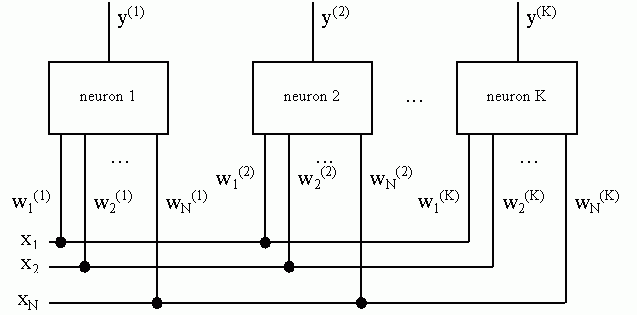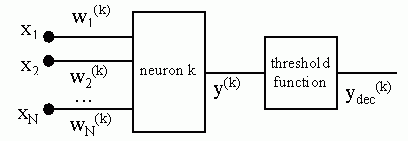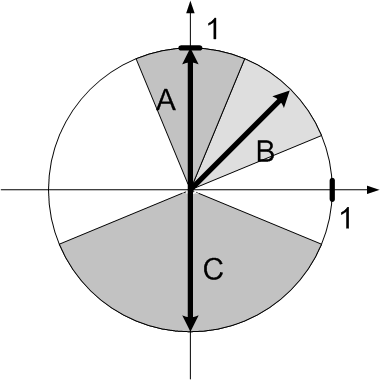::Notice !!! All calculations are based on assumption that vectors are normalised.::
The simplest neural network consists of one layer of neurons, which inputs are connected to each other,
Fig. 1. Such network might recognise as much different input vectors (e.g. characters) as the number
of common neural cells is. It is possible when all neurons have distinct synaptic weights.

Fig. 1. Layer of neurons
K - number of neurons,
N - number of neuron inputs.
When the input signal appears X = [x1; ...; xn; ...; xN], every neuron
generates response y(1), ..., y(k), y(K).
Thus, each output signal
has to be compared with others. The simplest method of doing such comparison consists in usage of separate
threshold functions (Fig. 2.) but these threshold values have to be set properly.

Fig. 2. Neuron with threshold function
Let's consider one-layer network that consists of two two-input neurons, Fig. 3.

Fig. 3. One-layer network: two two-input neurons
Let first neuron recognises input vector X = A = [a1; a2], and second neuron recognises
input vector X = B = [b1; b2]. Then such equations are satisfied:
w2(1) = a2
w1(2) = b1
w2(2) = b2
y(2) = w1(2)*a1 + w2(2)*a2 = b1*a1 + b2*a2 = cos(γ)
y(2) = w1(2)*b1 + w2(2)*b2 = b1*b1 + b2*b2 = 1
The attained results show that the response of the first neuron to vector B equals the response of the second neuron to vector A. The response of each neuron to "its" vector obviously equals 1. The threshold value may be set us arithmetic average of these answers:
For instance, the responses to vectors A = [0; 1] and B = [1; 0] (Fig. 4) are: 1 and 0 (vectors are perpendicular) The threshold value can be set as 0,5.

Fig. 4.
Taking into account greater number of neurons and vectros recognised by network the threshold value ought to equals the largest value computed for considered neuron. Naturally the greatest values are obtained for "the most similar" vectors. The angle between such vectors has the smallest value. Example. Vectors: A = [0; 1], B = [0,707; 0,707] and C = [0; -1], Fig. 5.

Fig. 5.
For each pair of vectors:
for vector A:
thAC = 0
thus thA = 0,854
thBC = 0.146
thus thB = 0,854
thCB = 0,146
thus thC = 0,146
Ryszard Tadeusiewcz "Sieci neuronowe", Kraków 1992
Adnrzej Kos, Wykład "Przemysłowe zastosowania sztucznej inteligencji", 2003/2004
mgr inż. Adam Gołda (2005)
Katedra Elektroniki AGH
Last modified: 06.09.2004
Webmaster